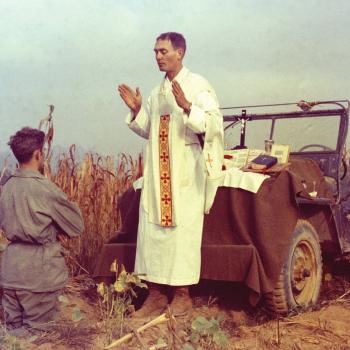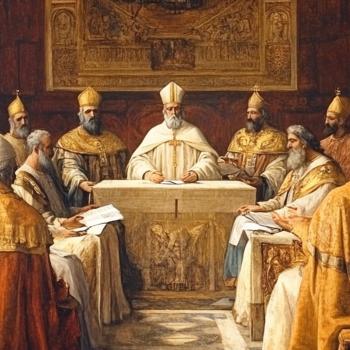Editors' Note: This article is part of the Patheos Public Square on Myth, Imagination, Fairy Tales, and Fantasy. And Faith. Read other perspectives here.
When confronted with the accusation "Your religion is just a myth!" most Christians would probably reply, "No, it's a fact." C. S. Lewis, the Oxford professor and author of the Narnia Chronicles, replied, "Christianity is both a myth and a fact. It's unique. It's the true myth."
Lewis became a Christian when he was 32, and the immediate human cause of his conversion was a long conversation with two friends, J. R. R. Tolkien and Hugo Dyson. Up until this point, whenever he thought about Christianity, Lewis tended to think of it as a set of doctrines and he wasn't really sure what those doctrines meant.
Tolkien and Dyson showed him (see Lewis's letter of 18 October 1931) that doctrines are not the main thing about Christianity. Doctrines are translations into our concepts and ideas of that which God has already expressed in "a language more adequate." The more adequate language was the actual incarnation, crucifixion, and resurrection of Christ. The primary language of Christianity is not doctrinal — not propositional or systematic — but historical: a lived language, the factual story of someone being born, dying, and living again in a new, ineffably transformed way.
When Lewis realised this, he began to gain an understanding of what Christianity really meant, because he was already fascinated — he had been fascinated from childhood — by stories of dying and rising gods. In many ancient mythologies there are stories of characters who die and go down into the underworld and whose death achieves or reveals something back here on earth: new life in the crops, for instance, or sunrise, or the coming of spring.
Lewis had always found the heart of these pagan stories — he mentions those of Adonis, Bacchus, and Balder — to be "profound and suggestive of meanings beyond my grasp even though I could not say in cold prose 'what it meant.'"
The difference between his attitude to Christianity and his attitude to the pagan myths was that, with the pagan myths, he didn't try officiously to explain them: these stories he considered to be fruitful enough in their own terms. They were myths that had to be accepted as saying something in their own way, not treated as a kind of allegory and translated into something less, something secondary, mere "doctrines."
When Lewis understood that Christianity too was to be approached first as a sequence of historical events and only secondarily as a doctrinal system, it was a huge breakthrough for him. Christianity, he began to see, was "the true myth" whereas pagan myths were merely "men's myths."
In paganism, God had expressed himself in an unfocussed way through the images that human imaginations deployed in order to tell stories about the world. But in Christianity God was expressing himself directly through the real, historical life of a particular man, in a particular place, at a particular time — Jesus of Nazareth, crucified under a Roman Procurator named Pontius Pilate, outside Jerusalem, circa A.D. 33.
That there were certain similarities between pagan myths and the true myth of Christianity did not lead Lewis to conclude, "So much the worse for Christianity"; it led him to conclude "So much the better for Paganism" (see his classic "Is Theology Poetry?"). Paganism contained a good deal of meaningful stuff that pointed to and was realised in the historical story of Christ.
In a sense, Lewis had found in pagan myths what Christ himself had said could be found in the Old Testament story of Jonah. Jesus told the Pharisees: "No sign will be given this generation except the sign of Jonah: for as Jonah was in the belly of the great fish for three days and nights, so the Son of Man will be in the heart of the earth for three days and nights" (Matthew 12:39-40). Jonah's descent and re-ascent were a meaningful prefiguration of Christ's own death and resurrection. For Lewis, pagan myths amounted to a similar sort of Christo-typical prefiguration.
A couple of weeks after his conversation with Tolkien and Dyson, Lewis passed over from being nearly certain that Christianity was true to being certain. He had come to share the view expressed by G.K. Chesterton in The Everlasting Man:
[The Incarnation of Christ] met the mythological search for romance by being a story and the philosophical search for truth by being a true story. That is why the ideal figure had to be a historical character as nobody had ever felt Adonis or Pan to be a historical character. But that is also why the historical character had to be the ideal figure; and even fulfill many of the functions given to these other ideal figures; why he was at once the sacrifice and the feast, why he could be shown under the emblems of the growing vine or the rising sun.
3/9/2016 5:00:00 AM




